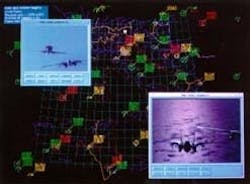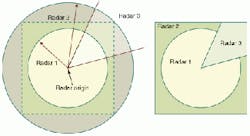Radar video generates tactical displays
Retrofitted US Navy assault ships incorporate a radar distribution network made up of off-the-shelf video and imaging products.
By Doug Lasniewski and Andreas Yerocostas
The US Navy has completed installation and sent to sea its new digital radar video data-distribution system (DRVDDS) aboard the USS Saipan and USS Nassau. These LHA-class amphibious assault ships were retrofitted under the Navy's LHA Advanced Combat Direction System upgrade.
Console display is similar to what Navy crew members would see aboard their assault ships, with various colored targets in the background. The airplanes in the video windows show the system's ability to highlight and define selected targets.
The DRVDDS is a shipboard local-area-network (LAN) distribution system for radar video and identification (IFF) messages. Data from all the radar and IFF sources on the ship are available at all times on the LAN. Every source can be selected independently at any OJ-724(V)/SYQ-24(V) tactical display console designed by engineers at the US Space and Naval Warfare Systems Center (San Diego, CA). The DRVDDS includes commercial off-the-shelf (COTS) radar-signal-processing and scan-converter products developed by Folsom Research Inc. (Rancho Cordova, CA).
During DRVDDS operation, radar video is digitized, formed into messages, distributed over a fiber distributed-data interface (FDDI) LAN, and then received and processed by a radar scan converter for display using the CX-4100 graphics system and monitors provided by BarcoView Inc. (Duluth, GA). The graphics system uses its lower eight planes of memory to provide a layered tactical display.
FIGURE 1. Radar video is received in analog form by radar broadcaster boards (RBBs, top left), digitized, and compressed for distribution over the VME bus. The CPU just below the RBB holds radar broadcast software in EPROM, which initializes all radar broadcaster boards and then controls data flow during operation by acting on as many as 2000 interrupts per second. The LAN interface board below the CPU links the digitized video to the local area network (LAN; center) for transmission to another LAN interface board in the console (top right). The console holds the scan-converter board set, comprising a radar receiver board (RRB), a scan-converter board (SCB), and a frame-buffer board (FBB). The SCBs and RBBs perform the raster conversion and data transfer to the graphics system for display, respectively.
The overall DRVDDS consists of three major subsystems. Radar broadcast equipment receives the analog radar signals, processes the video, and outputs digital video messages to the LAN; a FDDI LAN distributes the digital video messages to all users of the video system; and a radar scan converter processes and displays the digital video messages by interfacing to a workstation or the tactical display console's graphics system.
The DRVDDS is scalable to suit application requirements. For example, more radar broadcast equipment units can be used for connecting to multiple radars in different locations. One or more LANs can be used to handle all of the radar data (see Fig. 1). Optional LAN concentrators can connect the various ring segments of the FDDI LAN according to a star-configurated topology.
As many displays as necessary can be connected to the LAN. The data are received by an interface card and sent to the radar scan converter for display through the graphics system so no radar switchboards are required. All radar videos are available at all times and circulate the LAN with a latency of only a few milliseconds.
System breakoutFolsom Research Model 9415RB radar broadcaster boards interface the ship's radars to three FDDI LANs. The radar broadcast equipment, which includes one or more radar broadcaster boards, also has a CPU controller and one or more LAN interface boards.FIGURE 2. Composite display shows three radars as generated by a scan converter. A user-selectable number of output wedges (512, 1024, 2048, or 4096 pixels) is generated for each revolution of the radar antenna. Each of four radar videos can be transmitted as an independent data packet on the local-area network.
The radar broadcaster board is a VME board that receives analog radar video (as many as four channels), trigger, and azimuth signals from the radar and processes these inputs to provide data to the LAN. Azimuth and range-decimation techniques compress the radar video. Decimation is a processing method that uses peak detection or averaging to compress the huge amounts of data that result from radar video being sampled at a rate of 40 MHz over the maximum radar range for each trigger.
A user-selectable number of output azimuth wedges (comprising 512, 1024, 2048, or 4096 pixels) is generated for each revolution of the radar antenna. Range-decimation techniques compress the input samples to 2048 or 4080 range bin data samples per output wedge (see Fig. 2). These data, along with the header information, are output to the LAN interface card via VME64 block transfers. Each of the four radar videos can be transmitted as an independent data packet on the LAN.
The Folsom Model 9415RSC radar scan-converter-board set receives the radar information from the LAN and converts it to raster format for display. The scan converters are integrated with the advanced combat-direction system consoles, which consist of a CPU controller, the graphics display system, LAN interface boards, and VME-to-VME bridge boards.
The scan converter is a 6U VME COTS board set that consists of the radar receiver board, scan-converter board, and frame-buffer board. The scan converter receives digitized radar vector "data packets" from the FDDI LAN card(s) via VME64 block transfers and performs raster conversion. The frame-buffer board transfers the radar display data to the graphics system. Each of the three collocated radars can be range- and azimuth-gated to generate a composite "mosaic" display. Independent programmable persistence is supported for each radar.
Radar vectors written at different angles diverge as the range from a common origin increases. Eventually, the distance between adjacent vectors exceeds one pixel, creating a "hole" in the image. The resultant hole patterns in the image form undesirable moiré patterns. To eliminate this artifact, the radar scan converter uses proprietary "pixel fill" circuits to ensure that all image elements are updated by the radar scan.
Network elementsThe FDDI LAN interconnects the radar broadcast equipment with the consoles or workstations that include the scan converter. Multiple LANs may be used if necessary. If more than 80% of a FDDI LAN capacity (100 Mbits/s) is used, another LAN can be added.The LAN consists of a FDDI LAN card/network interface card and a LAN concentrator. The FDDI LAN card is the same as that used in the radar-broadcast-equipment transmit end of the system—a V/FDDI 5211 from Interphase Corp. (Dallas, TX). This card includes special firmware to support a direct VME D64 bus master interface with the radar scan converter running at up to a 35-Mbit/s continuous throughput. The firmware also supports the Express Transport Protocol to enable broadcast, multicast, and connection-oriented data transmissions. DRVDDS drivers are available for VxWorks, HP-RT, and HP-UX software.
The LAN concentrator is optional, but recommended, because it greatly adds to system reliability and forms the FDDI ring by interconnecting each remote FDDI card in a "star-shaped" topology. The LAN concentrator is a COTS system made by Performance Technologies Inc. (Rochester, NY) using PT-VME610 concentrator cards. Each card handles four remote FDDI cards, with one port per six-card group used as an expander.
The concentrator can be easily sized to accommodate a large number of radar broadcast equipment units and consoles. A dual concentrator system provides for a dual-attached FDDI LAN system giving 100% redundancy (primary and secondary fiber paths). Use of the concentrator precludes the need to use optical bypass switches on the FDDI LAN network interface cards.
Dissecting the boards The current implementation of the CPU is a COTS 33-MHz Motorola MVME167 processor card with 8 Mbytes of RAM. The diskless system uses the VxWorks 5.2 real-time operating system from Wind River Systems Inc. (Alameda, CA). The CPU processes up to 2000 interrupts per second from the radar broadcaster boards. It supports the Simple Network Management Protocol, uses a serial port for system control and monitoring, and currently supports an IFF data Ethernet interface with the AN/UPX-36(V)3 Central IFF to provide the radar operator with IFF target symbology and readouts.The CPU contains the radar-broadcast-equipment software in EPROM, which performs initialization of all radar-broadcast-equipment cards and then controls data flow during operation by acting on interrupts. The radar broadcaster board is a special-purpose radar video digitizer that processes the video into messages suitable for transmission over the LAN. It performs video digitizing at 40 MHz, with range bin samples of 2048 or 4080, provides azimuth resolution selection of 512, 1024, 2048, or 4096 azimuth increments per 360° scan, and supports a radar range of nine to 300 radar miles. (The Navy defines a radar mile as 2000 yards.)
A changeable azimuth module supports azimuth change pulse/azimuth range pulse and radar-display and distribution system data streams (via front-panel connectors), and synchro, dx/dy and digital q (backplane wiring) information.
The radar broadcaster board supports four video channels, and VME data transfers are made via DMA D64 boards. It offers various parameter controls, such as peak/average detection for azimuth integration, and incorporates on-board test patterns and radar and video status reporting. This board interrupts the CPU whenever a data message is ready to be transmitted. Generally, only one radar broadcaster board is needed to process all video.
Scoping the scan converterThe radar scan converter incorporates three independent radar channels and controls. The three channels of radar data can be range-azimuth-gated or additively mixed. Processing speed is 25 Mbits/s in video-add mode and 40 Mbits/s in gated mode. The design prevents unwanted moiré patterns in the display and provides 100% pixel fill for 60-rpm radar data. Resolution is 1024 x 1024 pixels, and separate on-board test patterns are available for each radar scan converter.The scan converter converts radar video data messages from polar to x-y format suitable for a raster-display monitor. Its card set receives messages from the FDDI LAN card and interfaces to the display's graphics system (see image on p. 27).
The scan converter also provides indexed auxiliary-video-interface compatibility with various BarcoView graphics systems, such as the CX-4100 boards used for LHA. Radar video is displayed using underlay graphic planes to show layered display data. The radar scan-converter library is compatible with HP-RT, HP-UX and Sun Solaris operating systems, and no kernel driver is required.
A two-card set forms a BIT-3 VME bridge for use with a VME split backplane. If it's used, a slave VME bus isolates all of the radar scan-converter data from the primary console bus.
The Navy crews of the two ships that have been upgraded with the DRVDDS have experienced few problems. Reliability has been excellent, the crews report.
DOUG LASNIEWSKI is digital-radar-video data-distribution-system project engineer at the US Space and Naval Warfare Systems Center, San Diego, CA 92152, and ANDREAS YEROCOSTAS is radar products manager at Folsom Research Inc., Rancho Cordova, CA 95670.
Company InformationBarcoView Inc.Duluth, GA 30097Web: www.barco.comFolsom Research Inc.
Rancho Cordova, CA 95670
Web: www.folsom.com
Interphase Corp.
Dallas, TX 75234
Web: www.iphase.com
Performance Technologies Inc.
Rochester, NY 14620
Web: www.pt.com
US Navy Space and Naval Warfare Systems Center
San Diego, CA 92152-5001
Web: www.spawar.navy.mil
Wind River Systems Inc.
Alameda, CA 94501
Web: www.wrs.com



